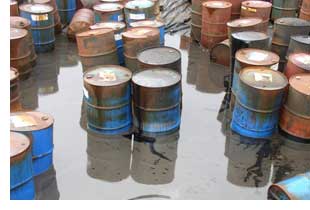Drums:
 Abandoned
and stockpiled containers, such as 55-gallon drums, may contain extremely hazardous materials. Therefore, evaluation of drum sites
and drum characterization must be performed by properly trained personnel. Improperly stored and mislabeled drums and bulk containers
may leak from rusted areas or become vandalized by people, causing contamination to air, land, and water.
Abandoned
and stockpiled containers, such as 55-gallon drums, may contain extremely hazardous materials. Therefore, evaluation of drum sites
and drum characterization must be performed by properly trained personnel. Improperly stored and mislabeled drums and bulk containers
may leak from rusted areas or become vandalized by people, causing contamination to air, land, and water.Hazards include detonations, fire, explosions, vapor generation, and physical injury resulting from moving heavy containers by hand. Drums that have deteriorated, or been improperly stacked, may also present dangers to people working around them. While hazards are always present, proper work practices - such as minimizing handling and using equipment and procedures that isolate workers from hazardous substances - can minimize the risks to site personnel. EPA's standard operating procedure for drum sampling outlines the hazards of excavating, inspecting, staging, opening, and sampling drums of unknown substances. OSHA regulations (29 CFR Parts 1910 and 1926) include general requirements and standards for storing, containing, and handling chemicals and containers, and for maintaining equipment used for handling materials. EPA regulations (40 CFR Part 265) stipulate requirements for types of containers, maintenance of containers and containment structures, and design and maintenance of storage areas. DOT regulations (49 CFR Parts 171 through 178) also stipulate requirements for containers and procedures for shipment of hazardous wastes.
Contaminants of Concern:
Each drum site will have different contaminants of concern. Most can be found searching online for fact sheets associated with each site or comparable sites. Contaminants may include, but are not limited to:- Pesticides
- Caustic chemicals
- Halogenated solvents
- Chlorinated solvents
- Petroleum products
- PCBs
Implementing Solutions:
Please submit your experiences (successes/challenges) and tribal-specific documents to share on our website using the attached form.Download Form
Resources:
EPA's SOP for Drum Sampling [pdf]EPA's Best Management Practices: Handbook for Hazardous Waste Containers [pdf]
Drum Handling Practices at Hazardous Waste Sites [pdf]
OSHA Handling Drums and Other Containers [pdf]
USEPA Science and Ecosystem Support Division Waste Sampling Guidance [pdf]
Websites:
Related Pages:
BrownfieldsContaminated Sites
Federal Facilities
Hazardous Waste and Emergency Response Training Requirements
Health Clinic
Superfund CERCLA
For more information, please contact:
Jennifer Williams, Alaska Program Coordinator, Sr.
Tel: 928/523-0673
Email: Jennifer.Williams@nau.edu
Tel: 928/523-0673
Email: Jennifer.Williams@nau.edu
Last updated: July 10, 2015
